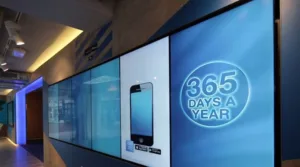Rob Brinklow is from RMG Networks, which used to be called “Symon Communications” and claims to be the largest publically-traded digital signage company providing end to end solutions. It is US owned.
The company has made its own CMS platform and hardware player but the key activity is to develop solutions and cover installation and support as well as system design. The company also has a content design agency.
A typical project was one with Bank of Ireland, which has 300 branches in Ireland and the UK. The firm started by working in networking and this was seen as an advantage in working with a bank as security is, of course, very important. The bank has been through troubled times but Brinklow said that he thinks that the company is quite visionary
The particular project he described was the establishment of a flagship branch of the bank in the Dublin City University and the first of five projects. The bank wanted to use the flagship branch to acquire new accounts and to develop its brand by working with the university which has a strong reputation. Brinklow said that it’s important to understand the “why” of a project before moving to the “how”.
The project includes a mixture of interactive and non-interactive applications and there was a decision to use the video facilities as a communication channel for the University.
The design is very open plan and the branch is open 24/7. There is plenty of seating and students are encouraged to use the branch as a facility. The layout is broken up into a number of zones.
One of the zones uses six Samsung UE46 displays in portrait configuration and the company used an RMG965 multiheaded media player that can support all the displays. The installation included directional audio and Kinect technology is used for gesture interaction and there is a measurement system of the audience. A second display zone uses the UE46 Samsung for interaction and uses a U Touch overlay. Another zone uses custom 10″ displays with capacitive touch that can be used sitting down for more private transactions.
The final zone used Multi-touch Samsung portrait displays.
One of the objectives was to create zones that could be scaled or replicated elsewhere. By looking at the way the zones were used, they could be rolled out to other branches which might just adopt a single zone configuration. Systems need to be simple and effective, Brinklow said, and the lesson learnt was that to work well, the system needs a blend of “hard coded” and dynamic content.
There is a short video about the project if you search for BOI DCU on youtube. http://tinyurl.com/popp4c7


